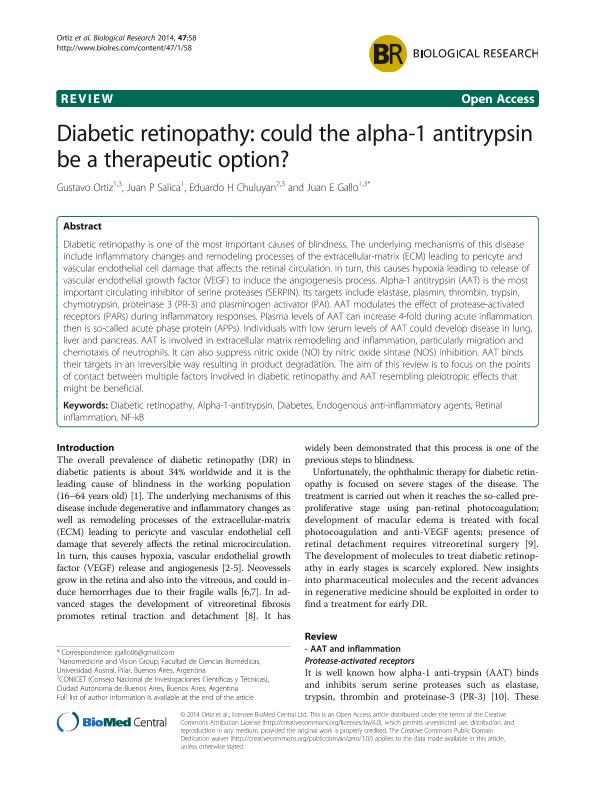Mostrar el registro sencillo del ítem
dc.contributor.author
Ortiz, Gustavo Alfredo

dc.contributor.author
Salica, Juan Pablo

dc.contributor.author
Chuluyan, Hector Eduardo

dc.contributor.author
Gallo, Juan Eduardo Maria

dc.date.available
2017-12-28T15:43:02Z
dc.date.issued
2014-11
dc.identifier.citation
Ortiz, Gustavo Alfredo; Salica, Juan Pablo; Chuluyan, Hector Eduardo; Gallo, Juan Eduardo Maria; Diabetic retinopathy: could the alpha-1 antitrypsin be a therapeutic option?; BioMed Central; Biological Research; 47; 11-2014; 58-67
dc.identifier.issn
0716-9760
dc.identifier.uri
http://hdl.handle.net/11336/31796
dc.description.abstract
Diabetic retinopathy is one of the most important causes of blindness. The underlying mechanisms of this disease include inflammatory changes and remodeling processes of the extracellular-matrix (ECM) leading to pericyte and vascular endothelial cell damage that affects the retinal circulation. In turn, this causes hypoxia leading to release of vascular endothelial growth factor (VEGF) to induce the angiogenesis process. Alpha-1 antitrypsin (AAT) is the most important circulating inhibitor of serine proteases (SERPIN). Its targets include elastase, plasmin, thrombin, trypsin, chymotrypsin, proteinase 3 (PR-3) and plasminogen activator (PAI). AAT modulates the effect of protease-activated receptors (PARs) during inflammatory responses. Plasma levels of AAT can increase 4-fold during acute inflammation then is so-called acute phase protein (APPs). Individuals with low serum levels of AAT could develop disease in lung, liver and pancreas. AAT is involved in extracellular matrix remodeling and inflammation, particularly migration and chemotaxis of neutrophils. It can also suppress nitric oxide (NO) by nitric oxide sintase (NOS) inhibition. AAT binds their targets in an irreversible way resulting in product degradation. The aim of this review is to focus on the points of contact between multiple factors involved in diabetic retinopathy and AAT resembling pleiotropic effects that might be beneficial.
dc.format
application/pdf
dc.language.iso
eng
dc.publisher
BioMed Central

dc.rights
info:eu-repo/semantics/openAccess
dc.rights.uri
https://creativecommons.org/licenses/by/2.5/ar/
dc.subject
Diabetes
dc.subject
Diabetic Retinopathy
dc.subject
Alpha-1-Antitrypsin
dc.subject
Retinal Inflammation
dc.subject.classification
Farmacología y Farmacia

dc.subject.classification
Medicina Básica

dc.subject.classification
CIENCIAS MÉDICAS Y DE LA SALUD

dc.subject.classification
Biotecnología relacionada con la Salud

dc.subject.classification
Biotecnología de la Salud

dc.subject.classification
CIENCIAS MÉDICAS Y DE LA SALUD

dc.subject.classification
Oftalmología

dc.subject.classification
Medicina Clínica

dc.subject.classification
CIENCIAS MÉDICAS Y DE LA SALUD

dc.title
Diabetic retinopathy: could the alpha-1 antitrypsin be a therapeutic option?
dc.type
info:eu-repo/semantics/article
dc.type
info:ar-repo/semantics/artículo
dc.type
info:eu-repo/semantics/publishedVersion
dc.date.updated
2017-12-11T16:52:39Z
dc.identifier.eissn
0717-6287
dc.journal.volume
47
dc.journal.pagination
58-67
dc.journal.pais
Reino Unido

dc.journal.ciudad
Londres
dc.description.fil
Fil: Ortiz, Gustavo Alfredo. Universidad Austral. Facultad de Ciencias Biomédicas; Argentina. Consejo Nacional de Investigaciones Científicas y Técnicas; Argentina
dc.description.fil
Fil: Salica, Juan Pablo. Consejo Nacional de Investigaciones Científicas y Técnicas; Argentina. Universidad Austral. Facultad de Ciencias Biomédicas; Argentina
dc.description.fil
Fil: Chuluyan, Hector Eduardo. Universidad de Buenos Aires. Facultad de Medicina; Argentina. Consejo Nacional de Investigaciones Científicas y Técnicas; Argentina
dc.description.fil
Fil: Gallo, Juan Eduardo Maria. Universidad Austral. Facultad de Ciencias Biomédicas; Argentina. Consejo Nacional de Investigaciones Científicas y Técnicas; Argentina
dc.journal.title
Biological Research

dc.relation.alternativeid
info:eu-repo/semantics/altIdentifier/url/https://www.ncbi.nlm.nih.gov/pmc/articles/PMC4335423/
dc.relation.alternativeid
info:eu-repo/semantics/altIdentifier/doi/http://dx.doi.org/10.1186/0717-6287-47-58
dc.relation.alternativeid
info:eu-repo/semantics/altIdentifier/url/https://biolres.biomedcentral.com/articles/10.1186/0717-6287-47-58
Archivos asociados
